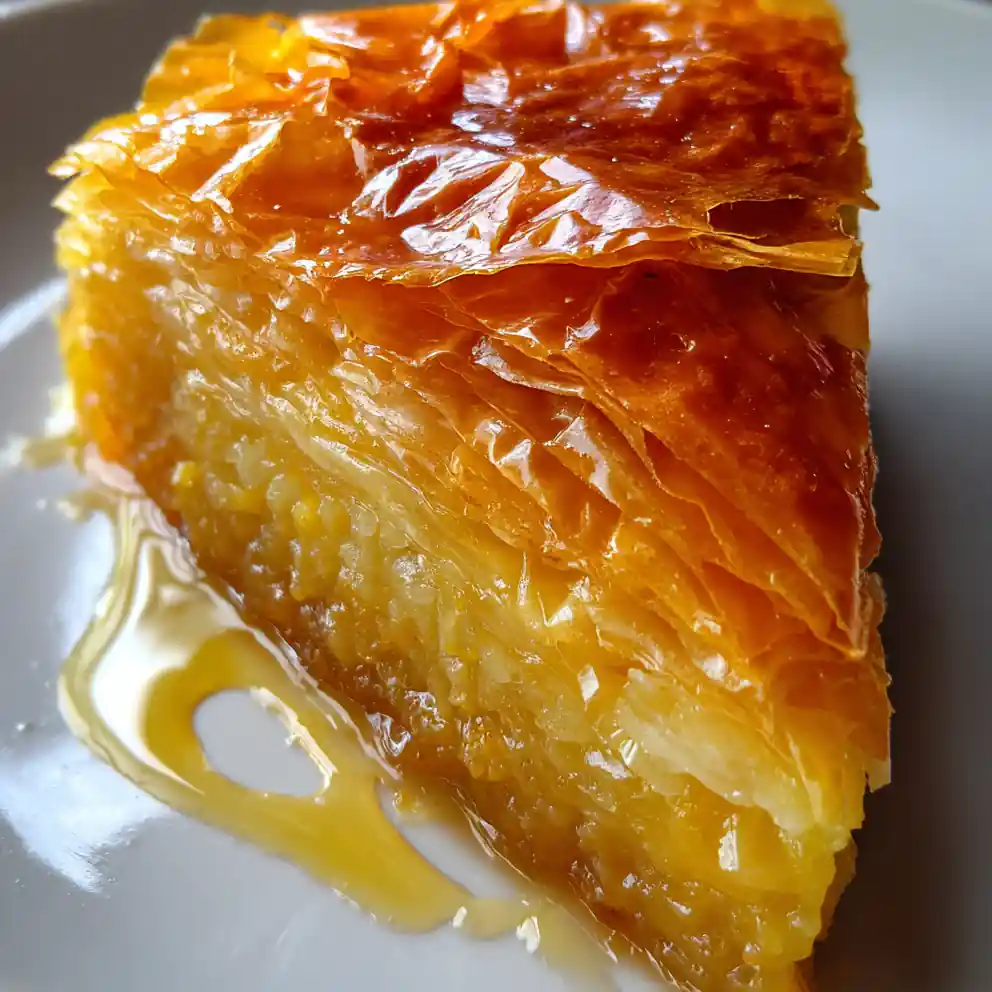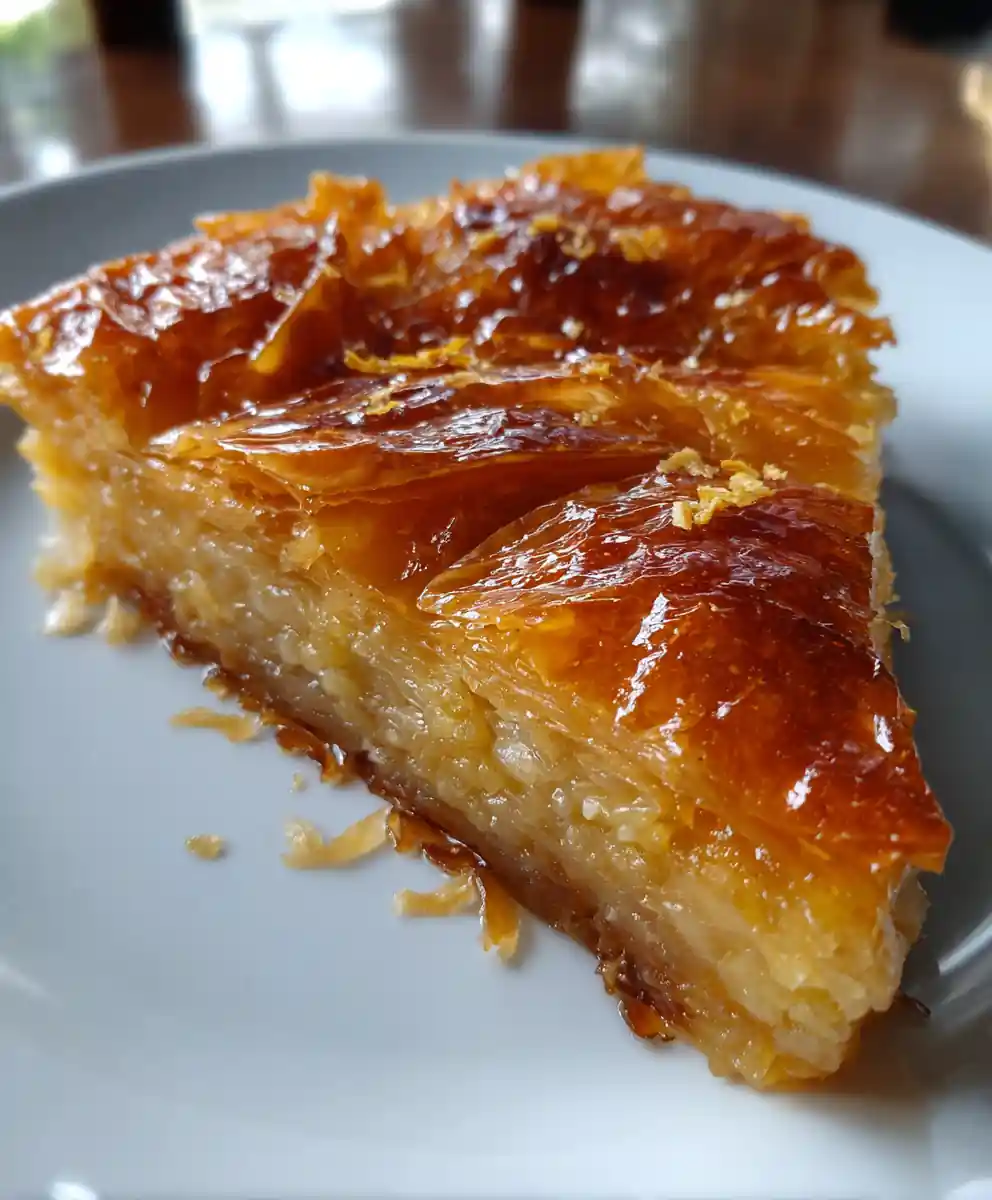I just love finding a dessert that feels both special and incredibly simple to whip up for family dinner ideas. This greek orange pie recipe Portokalopita style fills my kitchen with the most intoxicating citrus aroma, promising crispy edges and a creamy, syrup-soaked interior. Designed for busy families, this easy, hearty sweet transforms everyday ingredients into a truly memorable treat. It’s perfect for a Sunday dinner, offering a comforting end to any family meal.

Simple Ingredients for Your Delicious Portokalopita Style Pie
Core Ingredients
Crafting this delightful greek orange pie recipe Portokalopita style starts with a few accessible ingredients. Each plays a vital role in its signature texture and flavor.
- Phyllo Pastry: 1 lb (450g) – for that signature crinkly, crispy texture.
- Fresh Oranges: 2 large (zest and 1 cup juice) – for vibrant, essential citrus flavor.
- Eggs: 4 large – bind the pie and add richness.
- Granulated Sugar: 1 cup (200g) in batter, 1.5 cups (300g) in syrup – for balanced sweetness.
- Olive Oil: 1/2 cup (120ml) – provides moisture and a tender crumb.
- Plain Yogurt: 1 cup (240g) – for tang and extra tenderness (I usually use full-fat for best results).
- Vanilla Extract: 1 tsp (5ml) – enhances the overall sweetness and aroma.
- Water: 1 cup (240ml) – for the luscious syrup.
Optional Add-ins & Smart Swaps
- Orange Blossom Water: 1 tsp – for an extra aromatic touch (optional).
- Butter: 1/2 cup (113g) melted – use instead of olive oil for a richer taste (or sour cream if that’s what’s in the fridge).
- Dairy-Free/Gluten-Free: Use plain plant-based yogurt and, if available, gluten-free phyllo dough.
Premium/Healthy Variations
- Organic Oranges: For maximum natural flavor and to minimize pesticides.
- Whole Milk Yogurt: Enhances creaminess and richness, adding a satisfying depth.
Seasonal or Freshness Notes
For the best greek orange pie recipe Portokalopita style results, always pick fresh, fragrant citrus.
- Oranges: Ripe Navel or Valencia varieties are sweetest and juiciest.
- Meyer Lemons: Can offer a lovely, subtle citrus twist if oranges aren’t perfect.
Step-by-Step Preparation: Crafting Your Greek Orange Pie
Creating this satisfying greek orange pie recipe Portokalopita style is a rewarding experience, transforming simple components into a family-friendly dessert.
- Prep Your Oranges: Zest 2 large oranges (about 2 Tbsp), then juice them to yield about 1 cup (240ml) of fresh orange juice. Set these vibrant citrus elements aside for later.
Sensory: Bright orange zest aroma. Practical: ~2 Tbsp zest, 1 cup juice. - Shred the Phyllo: Unroll 1 lb (450g) of phyllo dough and gently crinkle or shred it into small pieces. Spread them out on a large baking sheet to air dry slightly for 15-20 minutes until crisp to the touch. This step is crucial for the classic Portokalopita style texture.
Sensory: Phyllo becomes brittle. Practical: 1 lb dough, 15-20 minutes drying time. - Mix the Batter: In a large bowl, whisk together 4 large eggs, 1 cup (200g) granulated sugar, 1/2 cup (120ml) olive oil, 1 cup (240g) plain yogurt, the orange zest, and 1 tsp (5ml) vanilla extract until the mixture is smooth and light yellow.
Sensory: Smooth, light yellow batter. Practical: Combine ingredients thoroughly. - Combine & Bake: Gently fold the dried phyllo pieces into the wet batter until evenly coated. Pour the mixture into a greased 9×13 inch (23x33cm) baking dish. Bake at 350°F (175°C) for 45-55 minutes, or until the top is golden brown and the center feels set. If it looks dry, splash in 1–2 Tbsp milk before baking to ensure moisture.
Sensory: Golden brown top, set center. Practical: 9×13 inch dish, 350°F (175°C), 45-55 minutes. - Make the Syrup: While the pie bakes, combine 1.5 cups (300g) granulated sugar, 1 cup (240ml) water, and the fresh orange juice in a saucepan. Bring to a boil, then reduce heat and simmer for 5-7 minutes until slightly thickened. Remove from heat and stir in an optional 1 tsp (5ml) orange blossom water.
Sensory: Syrup slightly thickens. Practical: Simmer 5-7 minutes. - Syrup Soak: Immediately pour the hot syrup evenly over the hot baked pie. You’ll hear a satisfying sizzle as the pie begins to absorb the liquid. Let it cool completely to room temperature (at least 2 hours) before serving, allowing the flavors to meld beautifully for a truly exceptional greek orange pie recipe Portokalopita style. For a low-sugar version, I’ve found reducing the sugar by 1/4 in both the batter and syrup still tastes wonderful.
Sensory: Sizzling sound, absorption. Practical: Cool for at least 2 hours.
Best Times to Enjoy and Storage Tips for Your Greek Orange Pie
This delightful greek orange pie recipe Portokalopita style shines at family dinners and holiday gatherings. It also makes for a wonderful afternoon treat with a warm cup of coffee or tea.
Serve slices plain, with a dollop of creamy Greek yogurt, or a scoop of vanilla ice cream. A light dusting of cinnamon adds a nice touch, and it pairs beautifully with strong coffee.
Store leftover greek orange pie, tightly covered, in the refrigerator for 4-5 days. I find it tastes even better the next day as the flavors deepen! Reheat gently in a warm oven (300°F/150°C) for 10-15 minutes or microwave individual slices for 30-60 seconds. Freezing is not recommended as it affects the texture.
Health, Nutrition & Lifestyle Benefits of This Greek Orange Pie Recipe
This homemade Greek orange pie recipe offers a wholesome dessert option, especially compared to highly processed store-bought varieties. It incorporates fresh fruit and yogurt, providing some natural goodness.
Enjoying this pie in moderation can be a satisfying end to any meal, fitting well into balanced eating. It provides a lovely burst of energy and can be a sweet component of easy healthy dinner ideas.
While not strictly a quick meal prep recipe or a high-protein snack, making it yourself offers control over ingredients for a family-friendly treat.

How This Recipe Matches Everyday Goals
This Greek orange pie recipe is a budget-friendly way to create an impressive dessert at home. It’s less time-consuming than it looks, perfect for busy schedules, and makes for fantastic family dinners.
Effortless Elegance
Simple steps truly yield a sophisticated dessert that looks like you spent hours in the kitchen.
Family Favorite
Its bright, sweet flavor is a crowd-pleaser, sure to bring smiles to all ages.
Make-Ahead Magic
The flavors meld and improve overnight, making it ideal for planning ahead for any gathering.
Pro Tips and Adjustments for Your Perfect Greek Orange Pie
For the best texture in your greek orange pie recipe Portokalopita style, ensure your phyllo is adequately air-dried; this helps it crisp up beautifully before soaking. Don’t rush the cooling process; allowing it to completely cool is crucial for flavor absorption.
Consider adding a pinch of ground cloves or cardamom to the syrup for a deeper, more complex flavor. A touch of rosewater can also lend an exotic aroma.
For a dairy-free version, use a good quality plant-based plain yogurt. For a less sweet, kid-friendly treat, you can reduce the sugar in both the batter and syrup by 1/4 cup each.
FAQs
Is this Greek orange pie recipe good for weight loss?
While truly delicious, this Greek orange pie recipe Portokalopita style is a dessert, meant to be enjoyed in moderation as part of a balanced diet. It’s not specifically designed for weight loss, but rather for wholesome enjoyment.
Where can I buy quality phyllo dough for Portokalopita?
Phyllo dough is typically found in the frozen foods section of most large grocery stores. Look near puff pastry or pie crusts for reliable brands; make sure it’s fully thawed before use.
Can I use this Greek orange pie recipe in meal prep plans?
Absolutely! This pie keeps wonderfully in the fridge for 4-5 days, making it an ideal make-ahead dessert for weekly meal planning. Just portion out slices and store them covered.
What kind of oranges are best for Portokalopita?
Navel or Valencia oranges are excellent choices for Portokalopita due to their sweetness and abundant juice. Any sweet, fragrant orange will yield fantastic results.
My phyllo dough keeps tearing, any tips?
Phyllo can dry out quickly, so work efficiently and keep unused sheets covered with a damp cloth. For this particular greek orange pie recipe, since you’re shredding it, small tears are less critical, but gentle handling helps.
Can I make a smaller batch of this Greek orange pie recipe?
Yes, you can easily halve all the ingredients and bake it in an 8×8 inch square pan. Adjust the baking time down slightly, checking for golden brown edges and a set center, for your smaller Greek orange pie.
This easy greek orange pie recipe Portokalopita style offers authentic Mediterranean comfort with minimal effort. It’s a satisfying dessert that promises warmth, bright flavors, and happy family memories. Save this family-friendly recipe to your Pinterest board and treat your loved ones to this delightful pie soon!

greek orange pie recipe Portokalopita Style
- Total Time: 190 minutes
- Yield: 10 to 12 servings 1x
- Diet: General
Description
This Greek orange pie (Portokalopita style) is an easy and comforting dessert with crispy edges and a creamy, syrup-soaked interior, perfect for family dinners. It fills the kitchen with a vibrant citrus aroma, transforming simple ingredients into a memorable sweet treat.
Ingredients
- 1 lb phyllo pastry
- 2 large fresh oranges, for zest and juice
- 4 large eggs
- 2.5 cups granulated sugar, divided for batter and syrup
- 0.5 cup olive oil
- 1 cup plain yogurt, full-fat recommended
- 1 tsp vanilla extract
- 1 cup water
- 1 tsp orange blossom water, optional
- 1 to 2 Tbsp milk, optional
Instructions
- Prep Your Oranges: Zest 2 large oranges (about 2 Tbsp), then juice them to yield about 1 cup (240ml) of fresh orange juice. Set these vibrant citrus elements aside.
- Shred the Phyllo: Unroll 1 lb (450g) of phyllo dough and gently crinkle or shred it into small pieces. Spread them out on a large baking sheet to air dry slightly for 15-20 minutes until crisp to the touch.
- Mix the Batter: In a large bowl, whisk together 4 large eggs, 1 cup (200g) granulated sugar, 0.5 cup (120ml) olive oil, 1 cup (240g) plain yogurt, the orange zest, and 1 tsp (5ml) vanilla extract until the mixture is smooth and light yellow.
- Combine & Bake: Gently fold the dried phyllo pieces into the wet batter until evenly coated. Pour the mixture into a greased 9×13 inch (23x33cm) baking dish. Bake at 350°F (175°C) for 45-55 minutes, or until the top is golden brown and the center feels set. If it looks dry, splash in 1–2 Tbsp milk before baking to ensure moisture.
- Make the Syrup: While the pie bakes, combine 1.5 cups (300g) granulated sugar, 1 cup (240ml) water, and the fresh orange juice in a saucepan. Bring to a boil, then reduce heat and simmer for 5-7 minutes until slightly thickened. Remove from heat and stir in an optional 1 tsp (5ml) orange blossom water.
- Syrup Soak: Immediately pour the hot syrup evenly over the hot baked pie. Let it cool completely to room temperature (at least 2 hours) before serving, allowing the flavors to meld beautifully.
Notes
For the best results, always pick fresh, fragrant Navel or Valencia oranges. Cool the pie completely for at least 2 hours after syrupping to allow flavors to meld. For a low-sugar version, reduce sugar by 1/4 in both the batter and syrup. Consider using 0.5 cup melted butter instead of olive oil for a richer taste.
- Prep Time: 20 minutes
- Cook Time: 50 minutes
- Category: Dessert
- Method: Baking
- Cuisine: Greek
Nutrition
- Serving Size: 1 slice (90 g)
- Calories: 380 calories
- Sugar: 48 g
- Sodium: 200 mg
- Fat: 22 g
- Saturated Fat: 8 g
- Unsaturated Fat: 12 g
- Trans Fat: 0 g
- Carbohydrates: 42 g
- Fiber: 2 g
- Protein: 7 g
- Cholesterol: 70 mg
Keywords: greek orange pie, Portokalopita, easy dessert, family dinner, citrus, syrup-soaked, phyllo, baking, yogurt
